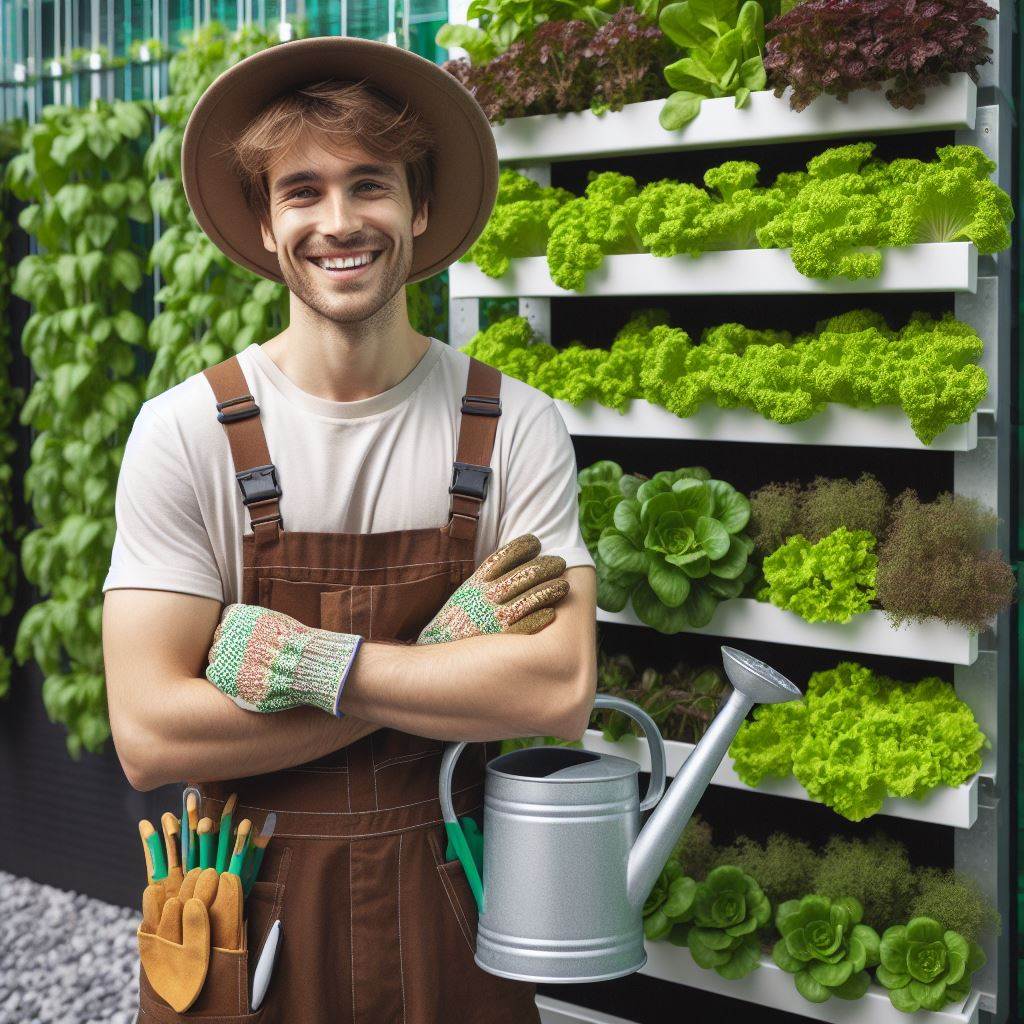Introduction
Urban farming refers to the practice of growing food and raising animals in small spaces within cities.
It is gaining popularity due to its numerous benefits, including increased access to fresh produce, reduced environmental impact, and improved community engagement.
In this blog post, we will explore the concept of urban farming in small spaces, providing valuable tips for maximizing yield.
We will discuss the importance of utilizing limited resources efficiently and how urban farming can be integrated into different environments, such as balconies, rooftops, and community gardens.
Tips for Successful Urban Farming in Small Spaces:
- Choose the right crops: Opt for plants that are well-suited for small spaces, such as herbs, salad greens, and dwarf varieties of fruits and vegetables.
- Vertical gardening: Utilize vertical space by using trellises, hanging baskets, and stacked containers to maximize the amount of produce grown.
- Container gardening: Grow plants in containers that fit the available space, ensuring proper drainage and using suitable soil mixes.
- Companion planting: Implement companion planting techniques to optimize space usage and increase crops’ resistance to pests and diseases.
- Intensive planting: Employ square foot gardening or intercropping methods to make the most of limited space and increase overall yield.
- Proper watering and fertilization: Provide plants with adequate water and nutrients by using drip irrigation systems and organic fertilizers.
- Pest control: Implement organic pest control methods, such as introducing beneficial insects and utilizing natural repellents.
- Regular maintenance: Monitor and manage plant growth by pruning, staking, and providing support as needed.
By following these tips, urban farmers can create thriving gardens within limited spaces, contributing to a sustainable and self-sufficient food system while enjoying the many personal benefits of gardening.
In short, urban farming is a valuable solution for individuals residing in small spaces who want to grow their own food. With careful planning and the right techniques, anyone can achieve a bountiful yield from their urban farm.
Choosing the Right Crops
Importance of selecting crops suitable for small spaces
Choosing the right crops is an essential step in successful urban farming.
Small spaces require careful planning, and selecting crops suitable for those spaces is crucial for maximizing yield and productivity.
Urban farmers often face limited space, but this should not limit their potential.
By choosing the right crops, urban farmers can create thriving gardens that yield an abundance of fresh vegetables, fruits, and herbs.
Examples of vegetables, herbs, and fruits that thrive in urban environments
When selecting crops for small spaces, it is important to consider the specific needs and requirements of each plant.
Some vegetables, herbs, and fruits are better suited for urban environments due to their adaptability, compact growth habit, and high yield.
Lettuce, for example, is an excellent choice for small gardens or containers as it can be continuously harvested using the cut-and-come-again method.
Compact tomato varieties, such as cherry tomatoes, are also ideal for small spaces and can be grown in hanging baskets or vertically to save space.
Transform Your Agribusiness
Unlock your farm's potential with expert advice tailored to your needs. Get actionable steps that drive real results.
Get StartedHerbs like basil, mint, and thyme thrive in urban environments and require minimal space to grow.
They can be planted in pots or along the edges of raised beds, providing fresh flavors and aromas for culinary use.
Strawberries are another great choice for urban farming, with options available for vertical gardens or hanging baskets.
These luscious fruits not only add color to the garden but also offer a sweet reward for the urban farmer.
Microgreens are becoming increasingly popular in urban farming due to their quick growth and high nutritional value.
These young vegetable greens are packed with essential vitamins and minerals, making them a valuable addition to salads and various dishes.
They can be easily grown indoors or outdoors in containers, making them an excellent choice for small spaces.
Considerations for selecting the right crops based on available space, sun exposure, and climate
When selecting crops for small spaces, it is important to consider the limitations and conditions of the urban environment.
Accurately measuring the available space is crucial to determine the number and size of crops that can be grown.
Sun exposure is another important factor to consider, as some crops require full sun, while others prefer partial shade.
It is essential to choose crops that are suitable for the amount of sunlight the space receives.
The climate of the urban environment also plays a significant role in crop selection.
Different plants thrive in different climates, so it is important to choose crops that are suitable for the specific conditions of the area.
Additionally, considering water requirements is essential in limited spaces. Some crops may require more frequent watering or irrigation systems to ensure adequate moisture.
In fact, selecting the right crops for small spaces is crucial in urban farming.
By considering the available space, sun exposure, and climate, urban farmers can maximize their yield and create thriving gardens.
With careful planning and thoughtful crop selection, small spaces can yield bountiful harvests of fresh and nutritious vegetables, herbs, and fruits.
Read: Vertical Farming: Future of Urban Agriculture
Vertical Gardening Techniques
Benefits of vertical gardening in urban settings
- Efficient use of limited space
- Increased crop yield per square foot
- Vertical gardens enhance visual appeal and add greenery to urban landscapes
- Improved air quality and reduction in urban heat island effect
- Easier access for watering, pruning, and harvesting
- Reduction of weed growth and pest infestation
Overview of different methods such as trellises, vertical planters, and hanging baskets
In urban environments, where horizontal space is limited, vertical gardening provides a perfect solution to maximize productivity with efficiency. Here are three popular methods:
- Trellises: Utilizing walls or fences, trellises allow plants to climb and grow vertically.
- Vertical Planters: These structures have multiple levels or pockets, enabling planting in a compact space.
- Hanging Baskets: Suitable for trailing plants, hanging baskets can be suspended from a balcony or vertical frame.
Tips for maximizing vertical space and increasing yield through proper plant placement and training
To make the most of vertical gardening, consider these essential tips:
- Choose the right plants: Opt for vining or trailing plants that adapt well to vertical growth.
- Plan for proper support: Install trellises, stakes, or frames to provide stability for climbing plants.
- Position for sunlight exposure: Ensure plants receive sufficient light and orient them accordingly.
- Provide adequate irrigation: Install a drip irrigation system or water regularly to prevent drying out.
- Train plants for optimal growth: Gently guide and secure plant stems or vines to trellises or supports.
- Rotate plant placement: Promote balanced growth and prevent diseases by rotating plant locations.
- Use companion planting: Incorporate companion plants to improve pest management and nutrient uptake.
- Prune regularly: Remove dead or damaged parts and promote air circulation for healthier plants.
- Fertilize appropriately: Feed plants with suitable organic fertilizers to ensure proper growth and yield.
- Harvest at the right time: Regularly monitor plants and harvest fruits or vegetables at their peak ripeness.
By implementing these techniques and strategies, urban gardeners can optimize their limited space and achieve impressive yields from their vertical gardens.
Read: Rooftop Gardens: Sky-High Green Spaces
Container Gardening
Container gardening is an excellent way to maximize small spaces and still enjoy the benefits of growing your own plants.
Whether you have a tiny balcony or a rooftop garden, container gardening can transform any limited space into a thriving green oasis.
Showcase Your Farming Business
Publish your professional farming services profile on our blog for a one-time fee of $200 and reach a dedicated audience of farmers and agribusiness owners.
Publish Your ProfileAdvantages of container gardening in limited spaces
The advantages of container gardening in limited spaces are numerous.
Firstly, individuals with constrained areas can still cultivate their favorite plants and vegetables.
With container gardening, even small balconies, patios, rooftops, or indoor spaces can be utilized to their maximum potential.
Another advantage is the flexibility it offers. Containers can be easily moved around, allowing plants to optimize sunlight exposure or adapt to changing weather conditions. T
his flexibility also enables the cultivation of different plants in separate containers, catering to individual preferences and varying growth requirements.
Selection of appropriate containers and soil for optimal plant growth
When selecting containers, it is important to consider their attributes.
Containers should have proper drainage systems and sufficient space for the plant’s root system to grow.
Commonly used materials include plastic, terracotta, or wooden containers, depending on personal aesthetics and preferences.
The choice of soil is equally important. A well-draining potting soil mix that retains moisture while ensuring excess water drains adequately is recommended.
Proper drainage holes in the containers are essential to prevent waterlogging and root rot, allowing plants to thrive.
Watering, fertilization, and pest control considerations in container gardens
In container gardens, watering becomes a critical factor. Since container plants have limited access to natural water sources, regular watering is necessary.
It is important to monitor soil moisture levels and water accordingly, ensuring proper hydration without overwatering and causing root damage.
In addition to watering, fertilization plays an important role in container gardens. The confined space of containers limits the nutrients available to plants.
Applying a balanced liquid fertilizer every few weeks helps provide essential nutrients for optimal plant growth and productivity.
Pest control is another consideration in container gardening. Watch out for common pests such as aphids, snails, or fungi that can affect plant health.
Take preventive measures such as using organic pest control methods or removing infested plants promptly to prevent pest infestations from spreading.
In general, container gardening is a fantastic solution for limited spaces. It offers numerous advantages, such as the ability to grow plants and vegetables in small areas.
By selecting appropriate containers, providing optimal soil conditions, and considering watering, fertilization, and pest control, anyone can successfully cultivate a thriving container garden.
Read: Urban Farming 101: Getting Started with Basics
Utilizing Microgreens and Sprouts
Introduction to microgreens and sprouts and their suitability for small-scale urban farming
Microgreens are tiny, immature versions of leafy vegetables and herbs that are harvested just a few weeks after germination.
Sprouts, on the other hand, are germinated seeds, beans, or grains that are typically harvested within a week.
Both microgreens and sprouts offer numerous benefits for small-scale urban farming.
They require minimal space, making them ideal for urban environments where space is limited.
Furthermore, they have a quick turnaround time, allowing for multiple harvests in a short period.
Microgreens and sprouts are also packed with nutrients, providing a fresh and healthy addition to urban dwellers’ diets.
Instructions on how to grow microgreens and sprouts indoors
- Choose the right container: Select shallow containers with drainage holes for growing microgreens. For sprouts, consider using sprouting-specific containers, such as mason jars or sprouting trays.
- Prepare the growing medium: Use a lightweight and sterile growing medium, such as potting mix or coconut coir, for microgreens. For sprouts, rinse the seeds thoroughly and soak them overnight.
- Sow the seeds: Spread the microgreen seeds evenly over the growing medium, ensuring they are not too crowded. For sprouts, distribute the soaked seeds evenly on the sprouting container.
- Provide optimal conditions: Place the microgreens and sprouts in a well-lit area with indirect sunlight. Maintain a temperature between 60-70°F and water them regularly to keep the medium moist.
- Monitor growth and harvest: Microgreens will be ready for harvest within 1-3 weeks. Harvest them by cutting just above the soil line. Sprouts can be harvested once they develop small leaves or shoots, usually within 3-7 days.
Suggestions for incorporating microgreens and sprouts into daily meals
- Salads: Add a vibrant touch to your salads by tossing in a handful of fresh microgreens or sprouts. They provide a burst of flavor and texture to complement your veggies.
- Sandwiches and Wraps: Elevate your sandwiches or wraps by layering a generous portion of microgreens or sprouts. They add a refreshing crunch and a hint of peppery taste.
- Smoothies: Boost the nutritional content of your smoothies by blending in a handful of microgreens or sprouts. Their mild flavors blend well with fruits and vegetables.
- Stir-fries and Stir-fried Rice: Enhance the color and taste of your stir-fries by adding microgreens or sprouts during the final minutes of cooking. They retain their crispiness and deliver a fresh touch to the dish.
- Pizza Toppings: Instead of traditional toppings, sprinkle microgreens or sprouts over your homemade or store-bought pizzas. They provide a unique and nutritious twist.
- Soups and Stews: Just before serving, garnish your soups and stews with a handful of fresh microgreens or sprouts. The vibrant greens will complement the warm flavors of the dish.
- Omelets or Scrambled Eggs: Mix microgreens or sprouts into your eggs for an added nutritional boost. They blend seamlessly with the eggs and provide a pleasant crunch.
In brief, microgreens and sprouts are excellent choices for urban farmers due to their suitability for small-scale cultivation.
By following simple instructions, anyone can grow these nutritious greens indoors. Incorporating them into daily meals adds both visual appeal and health benefits.
Start your urban farming journey with microgreens and sprouts to experience the joy of fresh, homegrown produce.
Read: Permaculture for Climate Change Adaptation

Managing Pest and Disease
Common issues faced in urban farming and their prevention strategies
- Lack of space and crowded conditions can lead to increased pest and disease problems.
- Minimize the risk by selecting disease-resistant plant varieties that perform well in urban environments.
- Implement proper sanitation practices, such as regularly cleaning tools and removing plant debris.
- Provide adequate air circulation and avoid overcrowding plants to reduce disease spread.
- Regularly inspect plants for signs of pests or disease and take immediate action when needed.
- Use physical barriers like row covers to protect crops from insects, birds, and other pests.
- Rotate crops each season to disrupt pest life cycles and reduce the buildup of specific pests.
- Introduce beneficial insects, like ladybugs and lacewings, to naturally control pest populations.
- Utilize trap crops, which attract pests away from main crops, and then remove or treat them accordingly.
- Monitor weather conditions and be prepared for sudden pest outbreaks triggered by environmental factors.
Organic pest control techniques for small-scale production
- Encourage biodiversity by planting a variety of crops, flowers, and herbs to attract beneficial insects.
- Handpick or manually remove pests from plants, especially during early stages of infestation.
- Apply organic pest control products, such as neem oil or insecticidal soaps, following label instructions.
- Make homemade pest sprays using ingredients like garlic, chili, or soap to deter insects.
- Introduce biological control methods, like nematodes or predatory insects, to target specific pests.
- Use natural predators like birds, bats, or frogs to control pest populations in urban farming spaces.
- Implement companion planting techniques to repel pests or attract beneficial insects.
- Install physical barriers like netting or fences to protect plants from larger pests like rabbits or deer.
- Regularly weed and maintain garden beds to eliminate hiding places for pests.
- Practice crop rotation, as different plants can deter specific pests and reduce infestation risks.
Disease prevention measures and proactive plant care practices
- Start with healthy plants from reputable sources to minimize the risk of introducing diseases.
- Avoid overwatering, as excess moisture can create conditions favorable for fungal and bacterial diseases.
- Implement proper irrigation methods like drip irrigation to avoid wetting foliage and spreading diseases.
- Mulch around plants to prevent soil-borne diseases and maintain even soil moisture levels.
- Remove and dispose of infected plant material immediately to prevent disease spread.
- Practice good hygiene by regularly washing hands and cleaning tools to prevent disease transmission.
- Maintain proper plant spacing to allow for good air circulation and reduce the risk of disease spread.
- Monitor plants closely for symptoms like wilting, yellowing, or spots and take prompt action.
- Utilize organic disease control methods like copper fungicides or biofungicides when necessary.
- Implement a strict crop rotation schedule to reduce the buildup of soil-borne diseases.
By implementing preventive strategies, utilizing organic pest control techniques, and practicing proactive plant care, urban farmers can successfully manage pest and disease issues in small spaces.
It is essential to remain vigilant and address any problems promptly to ensure a thriving urban farm.
Harvesting and Yield Optimization
Achieving a bountiful harvest and maximizing yield is crucial in urban farming.
Here are some tips to help you optimize your harvest and extend the growing season in small spaces:
Signs of Readiness for Harvesting Different Crops
- Tomatoes: Look for deep, rich color and firm texture without any green patches.
- Carrots: When the top of the carrot crown breaks through the soil, they are ready for harvest
- Lettuce: Harvest the outer leaves when they reach a length of 4-6 inches.
- Cucumbers: Pick them once they have reached a length of 6-8 inches and have a vibrant green color.
- Strawberries: Ripe strawberries are fully red and easily detach from the plant.
Techniques for Maximizing Yield and Extending the Growing Season in Small Spaces
- Intensive planting: Utilize vertical space and plant crops closer together to increase yield.
- Succession planting: Continuously sow seeds to have a constant supply of fresh produce throughout the season.
- Grow in containers: Opt for container gardening to maximize space and flexibility.
- Choose high-yield varieties: Select crop varieties that are known to produce a higher yield in smaller spaces.
- Utilize trellises and vertical structures: Train vining plants to grow vertically, saving space and increasing yield.
Proper Harvesting and Post-Harvest Handling Tips to Maintain Freshness and Quality
- Pick produce at the right time: Harvest crops when they are fully ripe for the best flavor and nutritional value.
- Use sharp tools: Use clean and sharp tools to harvest fruits and vegetables to prevent damage.
- Handle with care: Treat harvested produce gently to avoid bruising or any other damage.
- Wash and dry: Rinse harvested vegetables lightly to remove dirt, gently pat them dry, and store appropriately.
- Sort and store properly: Separate different crops to prevent spoilage and store them in appropriate containers or bags.
- Store at the right temperature: Different crops require specific temperature and humidity levels for optimal preservation.
- Regularly check for spoilage: Inspect stored produce to remove any damaged items and prevent the spread of spoilage.
Harvesting and maintaining the quality of your crops play a crucial role in urban farming success.
By following these tips, you can optimize your yield, extend your growing season, and enjoy fresh and delicious produce from your small space.
Case Studies and Success Stories
Urban farming has gained popularity in recent years as a sustainable solution to food production in small spaces.
In this section, we will highlight successful urban farming projects, share experiences and lessons learned from real-life examples, and provide inspirational stories to motivate readers to start their own urban farming journey.
Successful urban farming projects in small spaces
- The Rooftop Garden Project: In the heart of a bustling city, a group of passionate individuals transformed an abandoned rooftop into a thriving vegetable garden. They utilized vertical gardening techniques and optimized space to yield an impressive variety of produce.
- The Community Micro Farm: A small community in a residential neighborhood came together to cultivate a micro farm on unused land. By implementing raised beds and composting, they were able to produce an abundance of fresh vegetables, improving food security for the community.
- The Balcony Oasis: Even without a traditional garden, urban farmers can still make use of their small balcony space. By utilizing hanging baskets, potted plants, and hydroponic systems, individuals have successfully grown their own herbs, leafy greens, and even small fruits.
Sharing experiences and lessons learned from real-life examples
- Start small: Many successful urban farming projects started with just a few pots or a small plot of land. By starting small and learning along the way, farmers were able to gradually expand their operations and experiment with different techniques.
- Utilize vertical space: With limited ground space, urban farmers have discovered the importance of utilizing vertical space. By implementing trellises, vertical gardens, and hanging systems, they were able to grow more plants and maximize their yield.
- Embrace technology: Urban farmers have embraced technology to overcome the challenges of small spaces. From automated irrigation systems to smartphone apps that monitor plant health, technology has played a significant role in increasing efficiency and productivity.
Inspirational stories to motivate readers to start their own urban farming journey
- From Concrete Jungle to Green Paradise: A city dweller turned their small backyard into an urban oasis, filled with lush greenery and an abundance of vegetables. Their transformation inspired their neighbors to follow suit and create their own mini-farms.
- From Rooftop to Table: A restaurant owner in a cramped urban area decided to grow their own ingredients on the rooftop. Not only did they have a fresh supply of herbs and vegetables, but they also attracted customers who were intrigued by the farm-to-table concept.
- The Healing Power of Urban Farming: A group of individuals with mental health challenges found solace and purpose in urban farming. Through their shared experiences and the therapeutic benefits of growing food, they were able to create a supportive community and improve their overall well-being.
These case studies and success stories demonstrate the potential of urban farming in small spaces.
They prove that with determination, creativity, and a bit of knowledge, anyone can become a successful urban farmer.
So, what are you waiting for? Start your own urban farming journey today and reap the rewards of growing your own fresh, sustainable produce.
Showcase Your Farming Business
Publish your professional farming services profile on our blog for a one-time fee of $200 and reach a dedicated audience of farmers and agribusiness owners.
Publish Your ProfileConclusion
Throughout this blog post, we have explored the concept of urban farming and its numerous benefits.
We explored maximizing small spaces for high yields and diverse urban farming methods.
We touched on the significance of choosing suitable crops that thrive in urban environments and explored the benefits of vertical gardening and hydroponics.
Additionally, we learned about the importance of proper soil management and pest control methods in urban farming.
Feeling inspired by urban farming? Start your own venture today and embrace the possibilities!
Start small; no vast land needed for Urban Farming Tips. Transform even a petite balcony or rooftop into a thriving urban garden.
Start by researching suitable crops for your environment and invest in the necessary equipment.
Embrace initial challenges in urban farming; it’s a learning process to cultivate skills and increase harvests gradually.
As we conclude, it is important to recognize the potential impact of urban farming in our efforts to create sustainable and resilient cities.
By incorporating agriculture into urban spaces, we can address food security, reduce carbon emissions from transportation, and promote community engagement.
Furthermore, urban farming has the potential to mitigate the effects of climate change by improving air quality, regulating temperatures, and conserving water resources.
Ultimately, by embracing urban farming, we can create greener, healthier, and more self-sufficient cities for generations to come.




